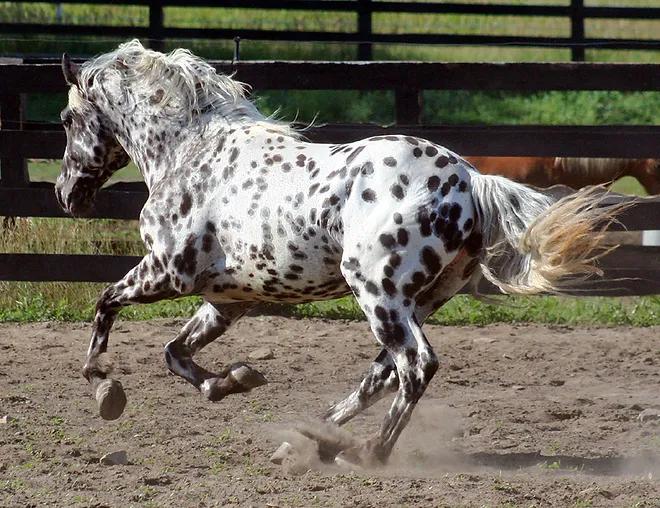Pattern 1 (PATN1)
Gene or Region: RFWD3
Reference Variant: T (N)
Mutant Variant: G (patn1)
Affected Breeds: Several
Research Confidence: High - Strong association in studied population
Explanation of Results: PATN1/PATN1 = homozygous for Pattern 1, trait expressed PATN1/n = heterozygous for Pattern 1, trait expressed n/n = no variant present
General Description of Pattern 1
Pattern-1 (PATN1) is strongly association with a variant of the RFWD3 gene that modifies the expression of leopard complex spotting. Horses that inherit PATN1 are generally born with a large amount (>60%) of LP-associated white spotting, whereas those without tend to have lower amounts (<40%). However, PATN1 has no apparent effect on any other white markings or spotting, and thus effectively “hides” in lp/lp horses. PATN1 is an example of a dominant trait, with both homozygous (PATN1/PATN1) and heterozygous (PATN1/patn1) displaying the same effect on patterning. Other minor variants further modify the extent of white patterning present at birth. The adult color is not a good indicator of PATN1 genotype as some low pattern horses “roan out” to large amounts of white patterning.
Genotype and Phenotype
-Double leopard with Pattern 1 (LP/lp, PATN1/n): Few spots or near few spots with CSNB -Single leopard with Pattern 1 (LP/lp, PATN1/n): Leopard or near leopard -Non-leopard with Pattern 1 (lp/lp, PATN1/n): No Leopard Complex Spotting -Double leopard without Pattern 1 (LP/LP, patn1/patn1): Snowcap, varnish with CSNB -Single leopard without Pattern 1 (LP/lp, patn1/patn1): Spotted blanket, varnish -Non-leopard without Pattern 1 (lp/lp, patn1/patn1): No Leopard Complex Spotting
-Spotting patterns generally follow after the color of the pigmented regions, for example “dun leopard” or “black silver snowcap.”
Gene Information
RFWD3 is a ubiquitin ligase that functions in the DNA damage response and DNA replication control. There are no known mutations in other species. The PATN1 associated variant is located within the 3' untranslated region and thus may regulate the expression of RFWD3.
References
Bellone RR et al., “Evidence for a retroviral insertion in TRPM1 as the cause of congenital stationary night blindness and leopard complex spotting in the horse.” (2013) PLoS One. 8 :e78280. PMID: 24167615
Holl H et al., “Variant in the RFWD3 Gene Associated with PATN1, a Modifier of Leopard Complex Spotting.” (2015) Anim Genet. 47: 91-101.
Druml T et al., "Phenotypic and genetic analysis of the leopard complex spotting in Noriker horses." (2017) J Hered. doi: 10.1093/jhered/esx039.
More Horse Color Genetics
Congenital Stationary Night Blindness & Leopard Complex
Congential Stationary Night Blindness (CSNB) is characterized by the inability to see well in low light and no-light situations. It is linked to Leopard Complex Spotting (LP), where homozygous horses (LP/LP) will have CSNB. Congential Stationary Night Blindness is present at birth and is non-progressive.
Champagne
Champagne (CH) is a dilution that affects all coat colors. Champagne foals are born with pink skin and blue eyes that slightly darken with age. Adult champagne horses have a distinct pumpkin colored skin with mottling in the hairless regions, as well as amber/green/tan eyes. Horses with multiple dilutions can be difficult to accurately identify color without genetic testing.
